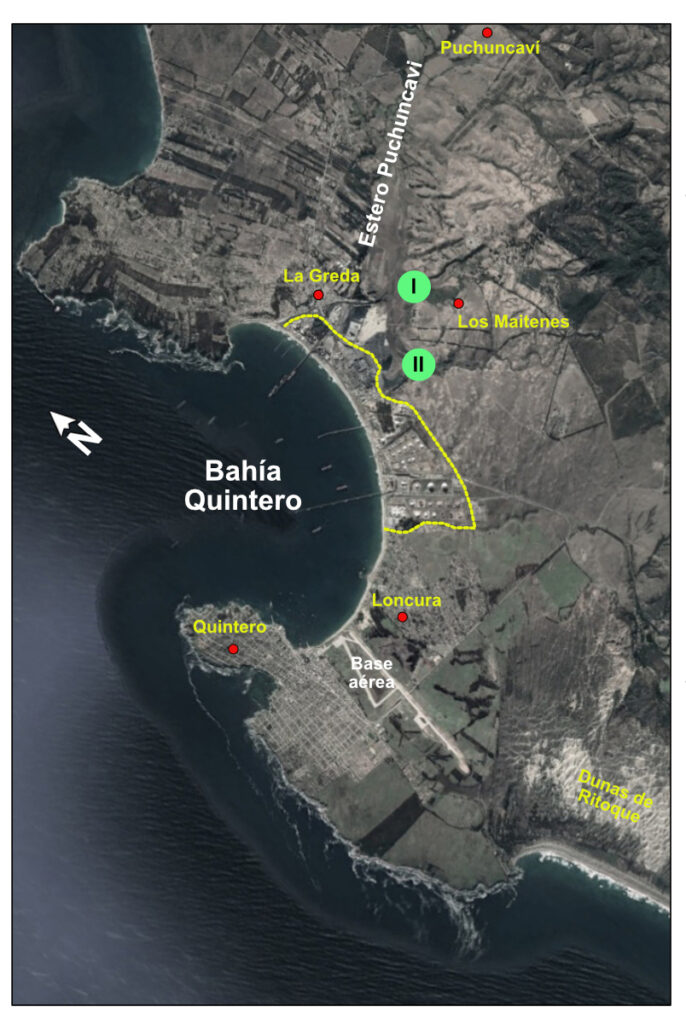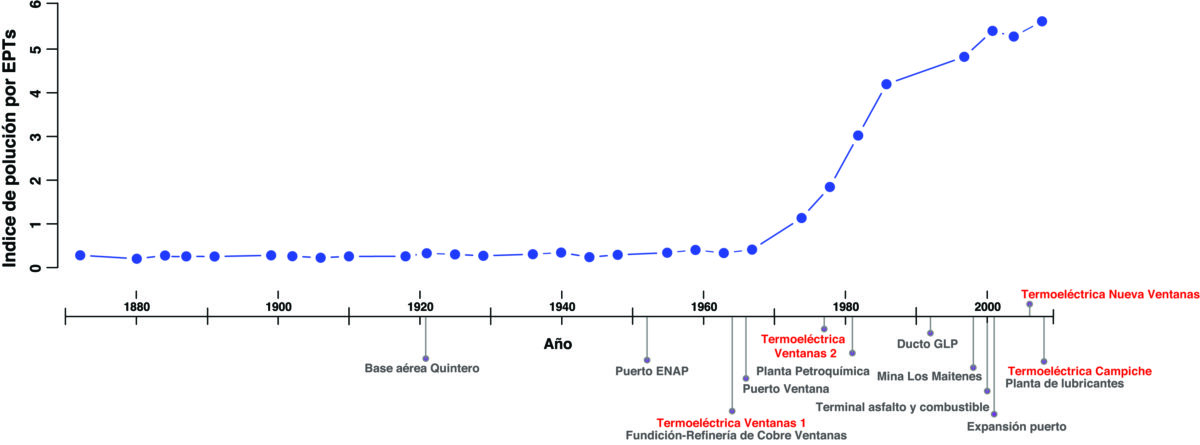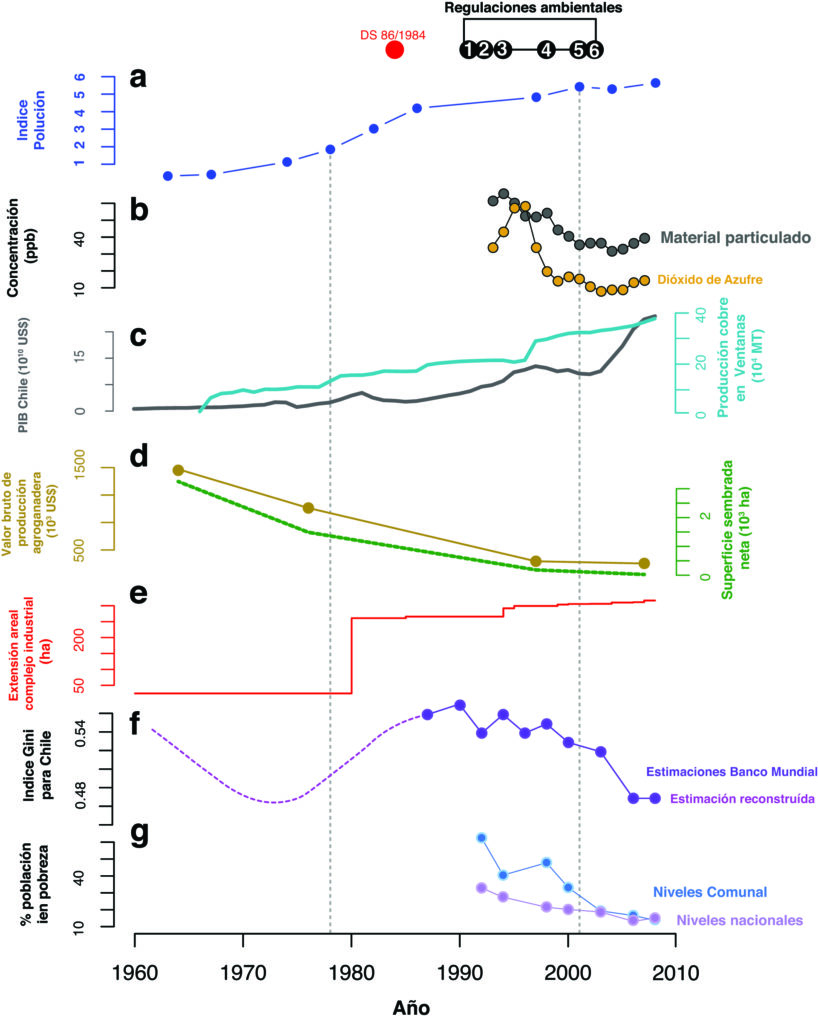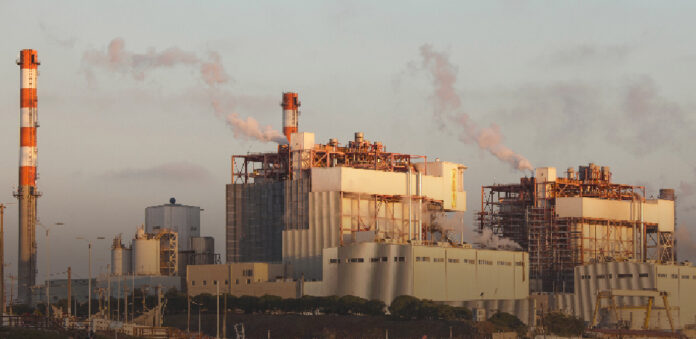- The socio-environmental history of Puchuncaví, a renowned sacrifice zone located in the Valparaíso Region, Chile, has been reconstructed for the last 136 years.
- An analysis of different variables showed that, after the arrival of industries in the area in the 1960s, its pollution rates increased exponentially.
- In the same period, the growth of Chile also increased. Still, the population of Puchuncaví barely exceeded the national poverty rate, demonstrating a clear fact of environmental injustice.
By Eugenia Gayo, Ariel Muñoz, Antonio Maldonado, Anahí Urquiza and Laura Gallardo
Go to Recommendations
Human productive activities have generated changes in planetary ecosystems, evidenced in the last 250 years, mainly since the Industrial Revolution. However, despite these advances’ progress and economic contribution, the negative impacts have greatly affected socio-ecological systems, where certain territories -the population and ecosystems- have been more degraded than others. Such is the case of the so-called sacrifice zones, which have risen worldwide since the mid-20th century.
In this context, a study published in the journal Earth’s Future sought to reconstruct the socio-environmental history of Puchuncaví, a renowned sacrifice zone located in the Valparaíso Region, Chile, integrating its historical pollution indices with macroeconomic trends, its indices of social inequality, and environmental regulations, from the end of the 19th century to the present.
To establish the historical levels of pollution in Puchuncaví, the presence of Potentially Toxic Elements (PTEs)[1] deposited in the sediments of the Los Maitenes wetland, close to the industrial complex of the commune, was analyzed (Figure 1). These sediments behave like files that store EPTs, providing information on emissions of long-lived pollutants; once released into the environment, they are deposited in ecosystems and do not disappear with natural processes; instead, they remain and accumulate in the territory.

Results
The sediments study allowed us to reconstruct the levels of eleven PTEs[2] trends between 1872 and 2008 (in addition to phosphorus). The PTEs begin to increase steadily from 1967 onwards, which fits precisely with the installation of the first thermoelectric plant and a copper smelter and refinery (Figure 2).

A significant presence and diversification of industrial activities in Puchuncaví generated an exponential increase in pollution, given in part by Supreme Decree (DS) 86/1984 that modifies the Valparaíso Intercommunal Plan. Meanwhile, its population economy had a marginal increase since local poverty levels have been comparatively higher than national rates (Figure 3). Added to this is the loss of traditional economic activities in the area, for example, agriculture, whose presence decreased due to the adverse effects of pollution.
On the contrary, Chile’s Gross Domestic Product (GDP) increased almost in tandem with the copper production increase from the Ventanas smelter and refinery and the installed capacity of energy generation from fossil fuel burning in local thermoelectric plants. That reflects social inequality and environmental injustice because while an increase in the country’s economic prosperity is appreciated, this would be at the cost of the socio-environmental degradation of Puchuncaví and its economy barely overcoming poverty.
Concerning the analysis of the State environmental regulations, it was determined that there were six that would have generated a decrease in the PTEs (Figure 3). These regulations were: Supreme Decree 185/1991, which regulates the operation of establishments that emit sulfur dioxide, particulate material, and arsenic throughout the territory of the republic; DS 252/1992, which approves the decontamination plan for the Las Ventanas industrial complex; DS 346/1994, which declares an area saturated by sulfur dioxide and particulate matter in the area surrounding the Ventanas industrial complex, Region V; DS 59/1998, which establishes the primary quality standard for breathable particulate material MP10, especially the values that define emergencies; DS 16/1998, which establishes an atmospheric prevention and decontamination plan for the Metropolitan Region; DS 45/2001, which modifies Decree No. 59, of 1998, which establishes the primary quality standard for breathable particulate material MP10; and Supreme Decree 113/2002, which establishes the primary air quality standard for sulfur dioxide.

Although these policies managed to control short-lived pollutants (sulfur dioxide and particulate matter) through the introduction of technologies, these instruments have fallen short of reducing the pollution load of PTEs in the area. Indeed, this reduction in these elements is very far from approaching the natural levels before the installation of industries.
Knowing the pre-industrial pollution indices reconstructed in the research would make it possible to visualize more ambitious policies that control long-lived pollutants currently not regulated by Chilean legislation.
Added to the high load of pollutants and environmental injustice, the study shows that the policies established in Puchuncaví must meet a series of conditions. Otherwise, the communities will continue to be exposed to the risks accumulated over five decades. For example, the just transition process[3] for the territory of Puchuncaví would not be guaranteed, even under a carbon neutrality scenario, to the extent that the communities would continue to be affected by the effects of unregulated long-lived pollutants, such as PTEs. The latter is especially critical considering that climate change would increase the frequency of extreme events in the central zone since storms, floods, or even droughts could remobilize accumulated pollutants towards local and nearby communities and ecosystems.
Recommendations
1. Develop public policies and actions aimed at mitigating, adapting, and rehabilitating the socio-ecological systems of Puchuncaví.
2. That any measure adopted in the area considers climate change management.
3. That the national energy transition policies aim at a fair transition, where the benefit of one community is not at the expense of another.
4. When establishing productive poles, not only the growth variable should be considered but also the well-being of the communities. One tool for this is to create policies that consider the preventive principle, which would prevent the birth of new slaughter zones.
5. Promote the regulation of primary and secondary standards for long-lived pollutants such as PTEs.
Notes
[1] PTEs correspond to elements found naturally in the environment at low concentrations. However, human activities can increase them. If these increase above a threshold value, their presence is harmful to human health and ecosystems. PTEs include copper, mercury, silver, chromium, lead, and molybdenum, among others.
[2] Copper, mercury, silver, lead, cadmium, zinc, tin, niobium, molybdenum, boron, and antimony.
[3] Reference is made to the transition towards environmentally and socially sustainable territories.
References
Gayo, E. M., Muñoz, A. A., Maldonado, A., Lavergne, C., Francois, J. P., Rodríguez, D., et al. (2022). A cross-cutting approach for relating Anthropocene, environmental injustice and sacrifice zones. Earth’s Future, 10, e2021EF002217





